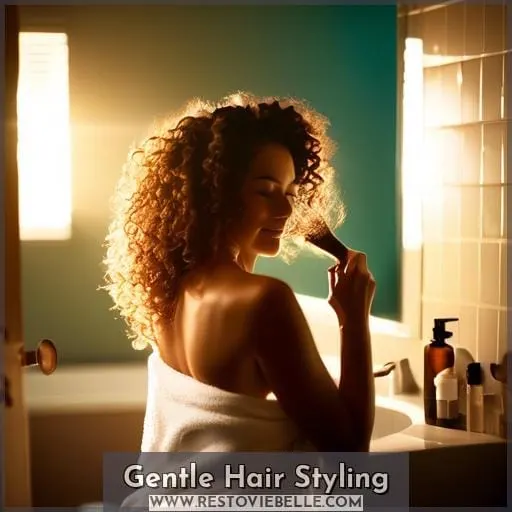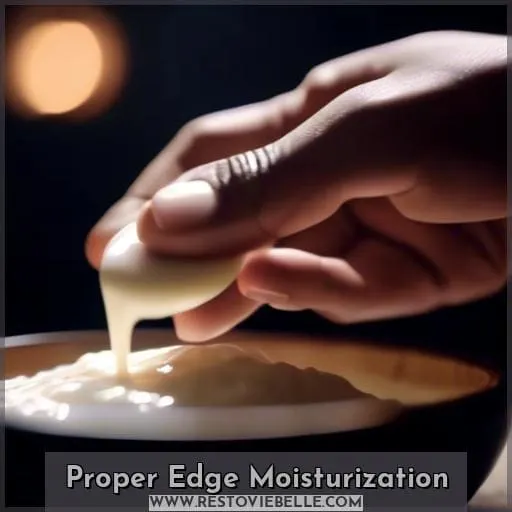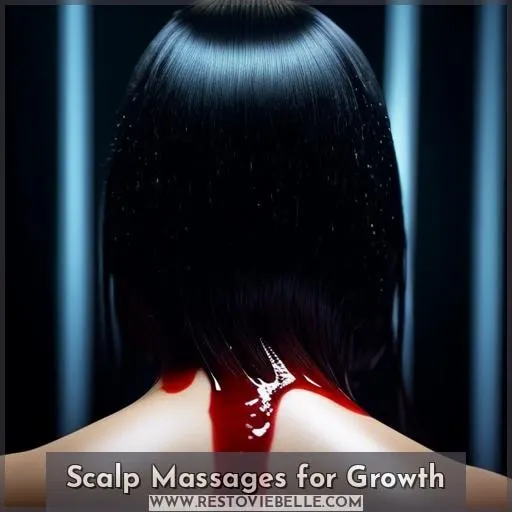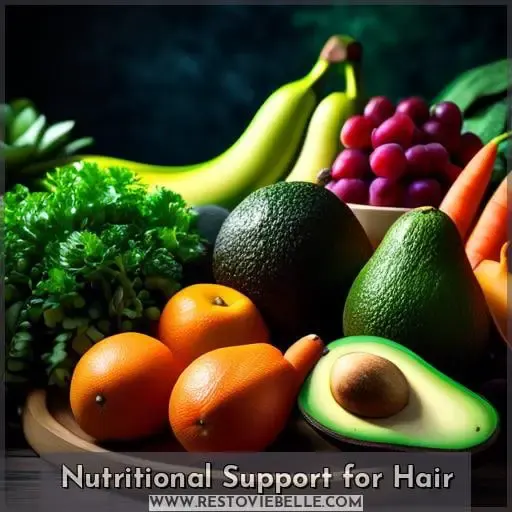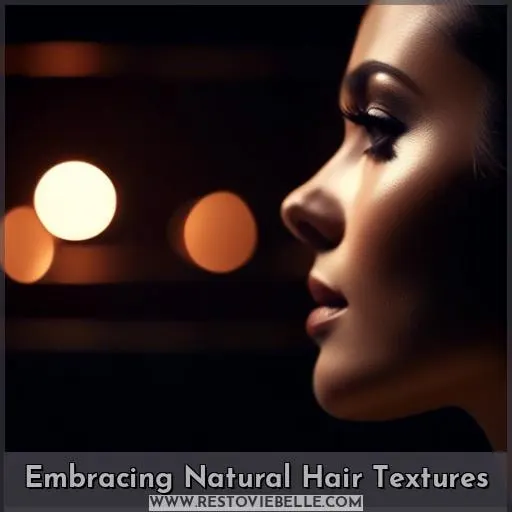This site is supported by our readers. We may earn a commission, at no cost to you, if you purchase through links.
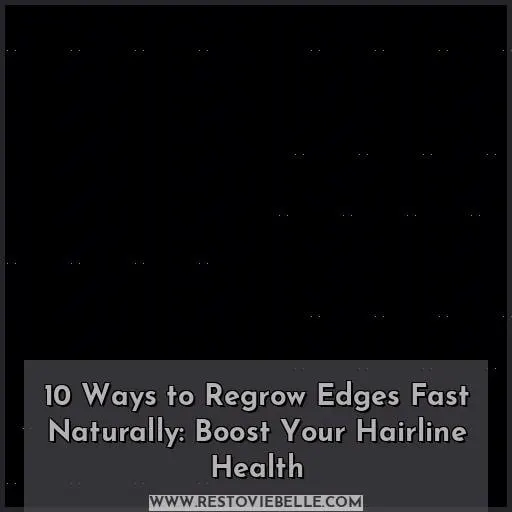 Struggling with thinning edges can feel like a losing battle, but it’s not all doom and gloom.
Struggling with thinning edges can feel like a losing battle, but it’s not all doom and gloom.
With the right natural tactics, you can declare victory over hairline woes. From gentle styling to the power of a good scalp massage, and the essential role of nutrition, there are ways to coax those edges back to life.
Ready to turn the tide? Let’s dive into 10 ways to regrow edges fast naturally and reclaim your hairline health.
Table Of Contents
- Key Takeaways
- Understanding Thinning Edges
- Gentle Hair Styling
- Proper Edge Moisturization
- Scalp Massages for Growth
- Nutritional Support for Hair
- Minimizing Heat and Chemical Use
- Regular Deep Conditioning
- Embracing Natural Hair Textures
- Patience and Consistency
- Frequently Asked Questions (FAQs)
- Can wearing hats or head coverings contribute to thinning edges or hairline?
- How does the pH level of hair care products affect the health of my hairline and edges?
- Are there any specific exercises or physical activities that can promote hair growth, particularly at the edges?
- How does long-term use of medications or supplements impact the health of my hairline and edges?
- Can changes in sleep patterns or stress levels have a noticeable effect on the condition of my edges?
- Conclusion
Key Takeaways
- Utilize natural oils like coconut oil, shea butter, castor oil, olive oil, and avocado oil to moisturize the scalp and edges, which can nourish and strengthen hair follicles.
- Incorporate scalp massages using fingertips or specialized tools to improve circulation, nourish hair follicles, and support the hair growth cycle.
- Adopt a diet rich in vitamins and nutrients such as biotin, omega-3 fatty acids, and vitamins A, C, D, E, as well as foods high in protein, antioxidants, and fatty acids to promote strong, healthy hair.
- Avoid tight hairstyles and excessive heat or chemical exposure to prevent traction alopecia and hair breakage, opting instead for gentle, protective styling methods.
Understanding Thinning Edges
If you’re noticing your hairline thinning, you’re not alone. Various factors, including styling practices and underlying health conditions, can lead to edge damage.
It’s crucial to identify these causes early and adopt a holistic approach to treatment, ensuring your hairline remains healthy and robust.
Causes of Hairline Thinning
Hairline thinning can stem from various causes, intertwining genetics, hormonal shifts, and scalp conditions.
Genetics often predominate, predisposing individuals to hair loss patterns observed in their lineage.
Hormonal changes, particularly during life transitions such as menopause or post-pregnancy, can significantly impact hair density.
Scalp conditions, ranging from fungal infections to autoimmune diseases like alopecia areata, disrupt hair follicle health, leading to hair loss.
Understanding these factors is crucial in exploring the 10 ways to regrow edges fast naturally, aiming for effective hair regrowth and optimal edge control.
Signs of Edge Damage
You might notice your edges thinning before any other signs of hair damage appear.
Dry scalp, often a precursor to hair issues, can exacerbate follicle damage and lead to hair breakage. If you’re experiencing scalp inflammation or see signs of product buildup, these could be early indicators of edge damage.
Traction alopecia, a result of tight hairstyles, and chemical exposure from styling products can also contribute to weakening your hairline.
Pay attention to changes in your hair’s texture and fullness, as these can signal reduced blood supply to the scalp and potential hair loss. If you suspect any of these symptoms, it’s essential to adjust your hair care routine to prevent further damage.
Gentle Hair Styling
When you’re aiming to regrow your edges naturally, it’s crucial to adopt gentle hair styling practices to avoid further damage.
You should steer clear of hairstyles that pull tightly on your hairline, which can lead to traction alopecia.
Instead, opt for looser, protective styles that maintain your hair’s health and give your edges the chance to recover.
Avoiding Traction Alopecia
To effectively avoid traction alopecia, it’s crucial to adopt gentle hair styling practices. This condition, characterized by hair loss due to constant pulling or tension on the hair follicles, primarily affects the edges of your hairline.
Opting for protective styles that minimize scalp tension can significantly reduce the risk of edge breakage.
Incorporating natural elements into your hair care routine, such as using native plants known for their erosion control properties, can also be beneficial. These plants, with their extensive root systems, metaphorically illustrate the importance of a strong foundation for both soil and hair health.
By reducing mechanical stress on your hair and nourishing your scalp with natural moisturizers, you can protect your thinning edges and promote healthier hair growth.
Alternatives to Tight Hairstyles
Switching to gentle hair styling can significantly improve the health of your edges.
- Use edge protectors and natural oils to nourish and shield your hairline.
- Incorporate scalp massages to enhance circulation, promoting growth.
- Opt for protective styling that minimizes tension, complemented by a healthy diet and natural remedies for optimal hair health.
Proper Edge Moisturization
Proper hydration is key to regrowing your edges quickly and naturally.
By using natural moisturizers, you’ll nourish and strengthen your hairline effectively.
This approach ensures a holistic and detail-oriented path to healthier edges.
Importance of Hydration
After easing up on tight hairstyles to prevent traction alopecia, it’s crucial to focus on scalp hydration.
Your moisturizing routine should include natural humectants like aloe vera, which draw moisture into the hair.
Adequate water intake supports this internal hydration process.
Employ hydration techniques such as regular scalp massages with oils rich in enzymes to maintain a healthy, hydrated hairline.
Natural Moisturizers for Edges
Maintaining healthy hair, especially around the edges, requires a holistic approach that includes proper moisturization. After understanding the importance of hydration, it’s crucial to delve into natural moisturizers that can nourish and protect your hairline.
Coconut oil, shea butter, castor oil, olive oil, and avocado oil are powerhouse ingredients that offer a range of benefits for your edges. These oils not only moisturize but also strengthen hair follicles, promoting healthier growth.
For instance, coconut oil is known for its ability to penetrate the hair shaft, offering deep moisturization and protection against breakage. Shea butter, rich in vitamins A and E, not only moisturizes but also provides essential nutrients that stimulate hair growth.
Castor oil is celebrated for its ability to enhance thickness and prevent hair loss, thanks to its ricinoleic acid content. Avocado oil, loaded with biotin and vitamins, can help in repairing and strengthening damaged hair.
Incorporating these natural oils into your hair care routine can significantly improve the health and appearance of your edges. By choosing the right oil or a combination of them, you can create a tailored regimen that addresses your specific hair needs, leading to vibrant, resilient edges.
Scalp Massages for Growth
Scalp massages are a key technique for stimulating hair growth, enhancing the health of your hairline.
By improving circulation, these massages not only relax you but also potentially boost hair thickness and growth by nourishing the follicles with increased blood flow.
Regularly incorporating scalp massages into your routine, using either your fingertips or specialized tools, can be a simple yet effective step towards achieving a healthier, fuller hairline.
Techniques for Stimulating Edges
After ensuring your edges are well-hydrated, it’s time to focus on stimulating growth through scalp massages.
Gently massaging your scalp can improve circulation, which is vital for hair growth. Use your fingertips to apply light pressure in circular motions, promoting scalp elasticity and encouraging nutrient-rich blood to nourish your hair follicles.
Edge protectors, like silk or satin scarves, can help maintain moisture and protect delicate hair overnight.
Benefits of Scalp Circulation
Enhancing scalp circulation is pivotal for fostering hair growth and overall scalp health.
- Nourishes Hair Follicles: Improved blood flow delivers essential nutrients and oxygen to the hair follicles, promoting stronger and healthier hair growth.
- Eliminates Toxins: Increased circulation helps in the removal of waste products and toxins from the scalp, preventing potential blockages that could inhibit hair growth.
- Stress Reduction: Scalp massages, a key method to boost circulation, can also lower stress levels, indirectly benefiting hair health by stabilizing hormone levels that influence hair growth.
- Supports Hair Cycle: Proper blood flow aids in extending the anagen (growth) phase of the hair cycle, resulting in longer, denser hair.
Incorporating scalp massages, utilizing essential oils, and adopting the inversion method are effective ways to enhance scalp circulation naturally.
Nutritional Support for Hair
To bolster your hairline health and encourage the regrowth of edges naturally, focusing on nutritional support is key.
Incorporating vitamins and foods that promote hair growth into your diet can make a significant difference.
Foods rich in protein, antioxidants, and fatty acids support the strength and growth of your hair.
Vitamins for Hair Health
To bolster your hairline health, focusing on vitamins for hair health is crucial. Biotin, a key player, supports keratin infrastructure, potentially preventing deficiency-related hair loss.
Prenatal vitamins, rich in biotin and omega-3s, are often touted for enhancing hair growth, though it’s essential to approach them with caution due to potential risks associated with high vitamin levels.
Omega-3 fatty acids, found in fish oil, play a significant role in scalp health by reducing inflammation and supporting hair follicles.
Vitamins A, C, D, and E, alongside minerals like iron and zinc, are fundamental for maintaining healthy hair and scalp. These nutrients aid in cellular turnover, immune function, and the prevention of hair loss.
Incorporating a balanced diet and considering supplementation can provide your hair with the nutritional support it needs for optimal growth and health.
Foods to Promote Regrowth
To bolster hair regrowth, focus on biotin supplementation and increasing your protein intake, essential for strong, healthy hair.
Incorporate omega-3 fatty acids, found in fish and flaxseeds, to nourish your scalp.
Regular scalp exfoliation removes dead skin, promoting growth.
Wear protective headwear to shield hair from damage.
Minimizing Heat and Chemical Use
When striving to regrow your edges naturally, it’s essential to minimize the use of heat and harsh chemicals, which can exacerbate hairline damage.
Overstyling with high temperatures and chemical treatments can lead to breakage and thinning, so consider protective styling options that safeguard your hair’s integrity.
By choosing styles that keep your hair ends tucked away and using less aggressive products, you’re taking a holistic approach to maintaining and enhancing your hairline’s health.
Risks of Overstyling
Maintaining a balanced diet for hair health is crucial, but it’s equally important to address the risks associated with overstyling.
Overstyling, particularly through heat styling, chemical processing, and excessive manipulation, can significantly damage your hair. Heat styling tools, such as blow dryers and flat irons, can lead to moisture loss, altering your hair’s keratin structure and making it prone to breakage.
Similarly, chemical treatments, while sometimes making hair appear thicker, can weaken hair’s internal structure if not carefully managed. Excessive manipulation, including tight hairstyles and constant restyling, puts additional stress on your hair, leading to breakage and potential hair loss.
To protect your hairline and overall hair health, it’s essential to minimize these practices, opting for gentler styling methods and treatments that preserve your hair’s natural integrity.
Protective Styling Options
To protect your hairline and encourage regrowth, consider these protective styling options:
- Twist Outs: A gentle way to style your hair without excessive tension.
- Leave-in Treatments: Apply these to keep edges hydrated and strong.
- Steam Treatments: Open hair follicles for better moisture absorption, promoting healthy growth.
Incorporate edge sealing techniques to lock in moisture, and opt for bonnet drying to minimize heat damage. These methods not only safeguard your hair but also support your desire for mastery over hair health and the freedom to enjoy various styles without compromising edge integrity.
Regular Deep Conditioning
To effectively regrow your edges and boost the overall health of your hairline, incorporating regular deep conditioning into your hair care routine is crucial.
This process not only strengthens fragile edges by infusing them with essential moisture and nutrients but also utilizes natural deep conditioners to penetrate deeply into the hair shaft, restoring vitality and elasticity.
By adopting this scientifically-informed, holistic approach, you’re taking a significant step towards revitalizing your hair’s natural beauty and resilience.
Strengthening Fragile Edges
After minimizing heat and chemical use to protect your hair, it’s crucial to focus on strengthening fragile edges through regular deep conditioning.
This step is vital for restoring moisture and resilience to your hairline. Deep conditioning treatments penetrate deeper into the hair shaft, providing essential nutrients and hydration.
For those dealing with hair loss or traction alopecia, incorporating hair vitamins into your regimen can further support hair health. Protective styles, when chosen wisely, can also aid in reducing stress on your edges.
Additionally, scalp treatments that stimulate blood flow can encourage growth. Remember, consistency in these practices is key to seeing improvements.
Natural Deep Conditioners
To naturally boost your hairline health and regrow edges, incorporating regular deep conditioning into your haircare routine is essential. Deep conditioning benefits your natural hair growth by penetrating the hair shaft to restore moisture and strength.
- Aloe Vera: Known for its healing properties, aloe vera can moisturize the scalp and hair, promoting a healthy environment for hair growth.
- Coconut Oil: This natural oil is rich in fatty acids that nourish and strengthen hair, reducing breakage and promoting shine.
- Honey: A natural humectant, honey attracts moisture to the hair, keeping it hydrated and preventing split ends.
By using these natural ingredients, you can create effective deep conditioners at home. Additionally, combining deep conditioning with scalp massage effectiveness can further stimulate hair follicles, enhancing growth.
Remember to look for edge product reviews to find the best options for your hair type and to tailor your haircare routines to your specific needs.
Embracing Natural Hair Textures
Embracing your natural hair texture is a key step in reducing tension on your edges and promoting regrowth.
By tailoring your haircare routine to suit your unique curls or coils, you can nurture your natural edges more effectively.
This approach not only supports the health of your hairline but also celebrates the beauty of your inherent hair texture.
Reducing Tension on Edges
After deep conditioning to strengthen your fragile edges, it’s crucial to continue with tension reduction techniques.
Embrace your natural textures to alleviate stress on your hairline. Protective styles, such as loose updos or twists, can safeguard your strands while promoting growth.
Styling alternatives that minimize pulling and tugging are essential. Maintain realistic expectations; hair regrowth is a gradual process.
Consistently nurturing your edges with gentle care will lead to healthier hair.
Haircare for Natural Edges
Caring for your natural edges requires a holistic approach that combines gentle handling, proper nutrition, and the right hair care products. After reducing tension on your edges, it’s crucial to focus on nurturing them back to health.
Your hair follicles and edge growth will benefit significantly from incorporating protective styles that minimize stress on these delicate areas. Opt for hairstyles that don’t pull tightly on your edges, such as loose buns or twists, to prevent further hair breakage.
Moisturizing is key to maintaining healthy edges. Use natural moisturizers and oils that can penetrate the hair shaft, providing the necessary hydration to prevent dryness and brittleness. Regular scalp massages with oils like castor or rosemary can stimulate blood flow, encouraging healthier hair growth.
Nutrition also plays a vital role in hair health. Ensure your diet is rich in vitamins and minerals that support hair growth, such as vitamins A, C, D, E, zinc, and omega-3 fatty acids. Sometimes, incorporating a daily multivitamin can help cover any nutritional gaps that might affect your hair’s health.
Patience and Consistency
When aiming to regrow your edges, it’s crucial to set realistic growth expectations and understand that hair regrowth is a gradual process.
Keep track of your progress over time with photos or a hair journal to observe changes and stay motivated.
Consistency in your care routine is key to achieving and maintaining healthy hairline growth.
Realistic Growth Expectations
After embracing your natural hair texture, it’s essential to set realistic expectations for regrowth.
- Understand that reversing hair loss causes takes time.
- Establish healthy habits, like a balanced diet and regular exercise.
- Celebrate gradual improvement, not overnight success.
Tracking Progress Over Time
Maintaining a healthy hairline requires patience and consistency, and tracking your progress over time is a key part of this journey.
By keeping a diary or using a calendar, you can document your hair care routine, treatments, and any changes you notice. Taking photos and measurements regularly allows you to visually compare your hairline’s health over time.
This methodical approach not only helps in identifying what works best for your hair but also keeps you motivated by visibly showing improvements.
Frequently Asked Questions (FAQs)
Can wearing hats or head coverings contribute to thinning edges or hairline?
Wearing hats or head coverings won’t directly cause thinning edges or a receding hairline. However, if they’re too tight, they can lead to traction alopecia, a form of hair loss resulting from constant pulling.
Keep hats clean and loose to avoid such issues.
How does the pH level of hair care products affect the health of my hairline and edges?
Hair care products with a pH higher than your hair’s natural range (5-
- can lift the cuticle, causing frizz, breakage, and dryness.
Lower pH products can help maintain hair health.
Are there any specific exercises or physical activities that can promote hair growth, particularly at the edges?
As Rome wasn’t built in a day, regrowing your edges requires patience and consistent effort.
Engaging in regular cardiovascular exercises like jogging can improve blood circulation to the scalp, promoting hair growth.
How does long-term use of medications or supplements impact the health of my hairline and edges?
Long-term use of certain medications or supplements can impact your hairline and edges, potentially causing hair loss. Medications like famotidine, hormone replacement therapy, isotretinoin, and nonsteroidal anti-inflammatory drugs, among others, have been linked to hair loss.
Notably, chemotherapy drugs are well-known for causing hair loss, which can begin within weeks of starting treatment. If you’re experiencing hair loss due to medication, consult your doctor for alternative treatments.
Supplements, especially when not medically necessary, can also contribute to hair loss, underscoring the importance of consulting healthcare professionals before starting any new medication or supplement regimen.
Can changes in sleep patterns or stress levels have a noticeable effect on the condition of my edges?
Yes, changes in sleep patterns and stress levels can significantly affect your hairline and edges.
Poor sleep can disrupt hair growth cycles, while stress can lead to a condition called telogen effluvium, causing hair to enter a resting phase and then shed.
Conclusion
Ironically, the journey to regrow edges fast naturally might seem like a quest for a mythical elixir. Yet, the truth is, the power to transform your hairline lies in the palm of your hands—quite literally.
By embracing gentle hair styling, keeping your scalp well-moisturized, and giving your hair the nutritional support it craves, you’re setting the stage for a comeback story worthy of its own spotlight.
As you embark on this journey, patience and consistency will be your best allies. So, keep at it, and soon, you’ll marvel at the resilience and regrowth of your edges. Your hairline’s health is in your hands, and with these 10 ways to regrow edges fast naturally, victory isn’t just possible—it’s inevitable.


